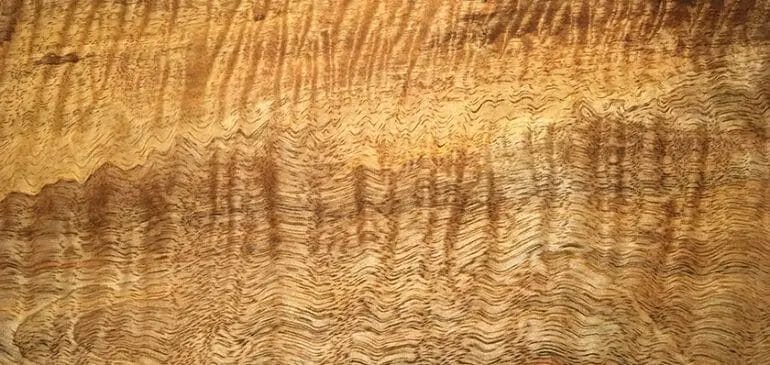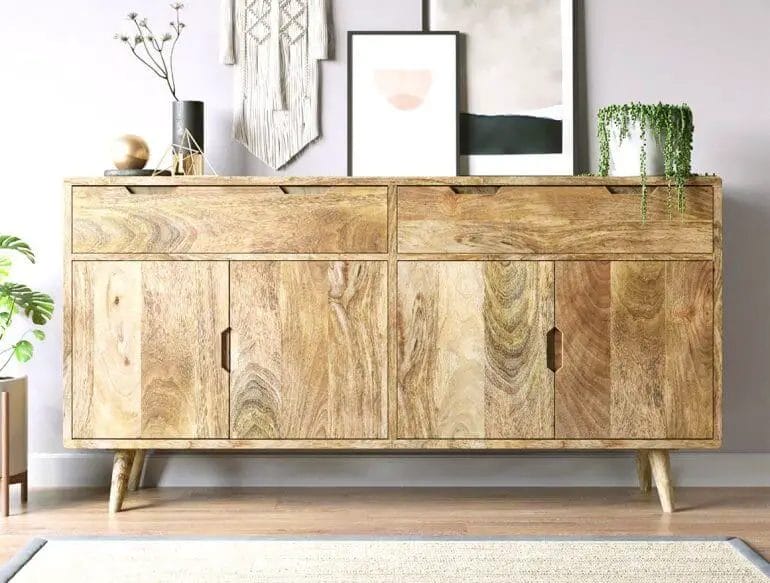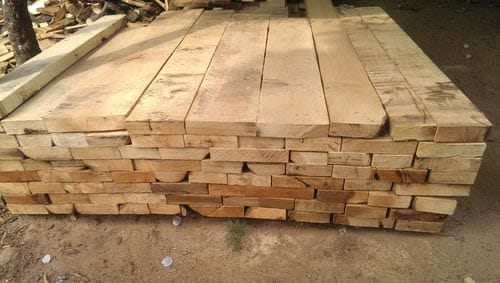Mango wood is an excellent choice for furniture due to its durability, unique grain patterns, and sustainable sourcing.
With its rich, warm color and natural beauty, mango wood adds a touch of elegance to any home decor.

Not only is mango wood aesthetically pleasing, but it is also known for its strength and resistance to warping, making it ideal for long-lasting furniture.
Furthermore, mango wood is considered an eco-friendly option as it comes from the sustainable harvesting of mango trees that no longer bear fruit.
So, if you’re looking for furniture that combines beauty, durability, and environmental consciousness, mango wood is a great choice.


The Unique Grain and Texture of Mango Wood Furniture
When it comes to furniture, the type of wood used plays a significant role in both its aesthetic appeal and durability. One type of wood that has gained popularity in recent years is mango wood. Mango wood is known for its unique grain pattern and texture, which sets it apart from other types of wood. In this section, we will delve into the characteristics of mango wood and explore why it is a desirable choice for furniture.
The Natural Beauty of Mango Wood
Mango wood is prized for its natural beauty and unique characteristics. The wood displays a wide range of colors, from light golden tones to dark brown, with streaks of black or green. This natural color variation adds depth and richness to furniture made from mango wood.
One of the distinguishing features of mango wood is its grain pattern. The grain can vary from straight to interlocking, creating a visually interesting surface. The swirling patterns and knots that are often present in mango wood add to its rustic charm.
Durability and Strength
Mango wood is not only visually appealing but also known for its durability. It is a dense hardwood, which makes it resistant to wear and tear. This makes mango wood furniture suitable for everyday use and long-lasting.
Furthermore, mango wood is resistant to water and moisture, making it less prone to warping or cracking. This makes it an excellent choice for furniture that may be exposed to fluctuating humidity levels.
Eco-Friendly and Sustainable
Another advantage of mango wood furniture is its eco-friendliness. Mango trees are fast-growing and prolific, reaching maturity in about 15 years. This makes them an excellent renewable resource for furniture production.
Using mango wood for furniture also reduces waste. Mango trees produce fruit for about 20-30 years, after which they are usually cut down to make way for new trees. By utilizing the wood from these trees, furniture makers can give them a second life, reducing the environmental impact.
Versatility in Design
Mango wood’s unique characteristics make it a versatile choice for furniture design. Its natural beauty and distinct grain pattern make it suitable for both rustic and modern styles. Whether it’s a farmhouse-inspired dining table or a sleek, contemporary coffee table, mango wood can easily adapt to different design aesthetics.
The wood’s rich color and texture also make it an excellent choice for adding warmth and character to any living space. From bedroom furniture to kitchen cabinets, mango wood can elevate the overall look and feel of a room.
Caring for Mango Wood Furniture
To ensure the longevity of mango wood furniture, proper care and maintenance are essential. Here are a few tips:
- Regularly dust the furniture to prevent the buildup of dirt and debris.
- Avoid placing mango wood furniture in direct sunlight, as it can cause fading or discoloration.
- Use coasters or placemats to protect the surface from hot or wet items.
- Apply a wood conditioner or polish occasionally to maintain the wood’s natural luster.
- Avoid using harsh chemicals or cleaners that can damage the wood.
In summary, mango wood furniture offers a unique blend of natural beauty, durability, and eco-friendliness. Its distinct grain pattern and textures make each piece one-of-a-kind, adding character to any space. Whether you’re looking for a timeless rustic piece or a modern statement, mango wood furniture is a versatile and sustainable choice.

Eco-Friendly Benefits of Choosing Mango Wood Furniture
When it comes to furniture, many people are becoming more conscious of the environmental impact of their choices. One sustainable option that is gaining popularity is mango wood furniture. Not only does it offer a beautiful and unique aesthetic, but it also comes with a range of eco-friendly benefits. In this section, we will explore some of the reasons why choosing mango wood furniture is a great choice for those looking to reduce their carbon footprint and make a positive impact on the environment.
1. Renewable Resource
Mango wood is harvested from mango trees, which are a fast-growing, renewable resource. Unlike other types of wood that can take decades to grow to maturity, mango trees reach maturity in just 15-20 years. This rapid growth rate makes mango wood a highly sustainable choice for furniture production.
2. Utilizes By-Products
Another eco-friendly aspect of mango wood furniture is that it often utilizes by-products of the mango industry. When mango trees no longer bear fruit, they are typically cut down to make room for new trees. Instead of allowing these trees to go to waste, the wood can be repurposed for furniture. This reduces the need for deforestation and helps to make the most of available resources.
3. Reduced Carbon Emissions
Mango wood furniture has a lower carbon footprint compared to furniture made from other materials, such as plastic or metal. The production process for mango wood furniture requires significantly less energy and emits fewer greenhouse gases. By opting for mango wood furniture, you are indirectly contributing to the reduction of carbon emissions and promoting a healthier planet.
4. Durable and Long-Lasting
Mango wood furniture is known for its durability and longevity. This means that it is less likely to end up in landfills as quickly as other types of furniture. By investing in high-quality mango wood furniture, you can enjoy its beauty and functionality for many years to come, reducing the need for frequent replacements and ultimately minimizing waste.
5. Biodegradable and Recyclable
One of the key eco-friendly benefits of mango wood furniture is its biodegradability and recyclability. When mango wood furniture reaches the end of its lifespan, it can be easily biodegraded and returned to the earth without causing harm to the environment. Additionally, the wood can be recycled or repurposed for other projects, further reducing waste and promoting a circular economy.
6. Chemical-Free Option
Mango wood furniture is typically crafted without the use of harmful chemicals or synthetic treatments. This makes it a healthier choice for your home and reduces the release of potentially toxic substances into the environment. By opting for mango wood furniture, you are supporting a more natural and sustainable approach to furnishing your space.
7. Supports Local Communities
Choosing mango wood furniture also has social and economic benefits. Mango wood is often sourced from regions where mango trees are abundant, supporting local communities and providing employment opportunities. By purchasing mango wood furniture, you are directly contributing to the livelihoods of these communities and helping to improve their quality of life.
In summary, mango wood furniture offers a range of eco-friendly benefits, making it a sustainable choice for environmentally conscious individuals. It is a renewable resource, utilizes by-products of the mango industry, has reduced carbon emissions, is durable and long-lasting, biodegradable and recyclable, chemical-free, and supports local communities. By opting for mango wood furniture, you can enjoy beautiful and functional pieces while making a positive impact on the environment.
How to Care for and Maintain Mango Wood Furniture
When it comes to furniture, mango wood has gained popularity for its durability and unique grain patterns. However, like any other type of wood, mango wood furniture requires proper care and maintenance to ensure its longevity. In this section, we will discuss some essential tips on how to care for and maintain mango wood furniture.
1. Dust Regularly
Regular dusting is an important step in maintaining mango wood furniture. Use a soft, lint-free cloth or a microfiber duster to remove any dust particles that may accumulate on the surface. Avoid using abrasive materials or harsh chemicals, as they can damage the wood.
2. Avoid Direct Sunlight
Direct sunlight can cause the mango wood to fade and lose its natural color over time. To protect your furniture, avoid placing it in areas where it will be exposed to direct sunlight for extended periods. If you cannot avoid sunlight exposure, consider using curtains or blinds to block the rays.
3. Use Coasters and Placemats
To prevent water rings, stains, and scratches, always use coasters and placemats when placing hot or cold objects, glasses, or plates on your mango wood furniture. This will help to protect the surface from any potential damage and preserve its appearance.
4. Clean Spills Immediately
If any spills occur on your mango wood furniture, it is crucial to clean them immediately to prevent stains. Use a damp cloth and mild soap to gently wipe away the spill, then dry the area thoroughly. Avoid using excessive water, as it can penetrate the wood and cause damage.
5. Avoid Extreme Temperatures and Humidity
Mango wood is sensitive to extreme temperatures and humidity levels. Avoid placing your furniture near sources of heat, such as radiators or fireplaces, as this can cause the wood to warp or crack. Additionally, keep your furniture away from areas of high humidity, such as bathrooms or basements, to prevent moisture damage.
6. Apply Furniture Polish
To maintain the natural beauty of mango wood, you can occasionally apply furniture polish designed for wooden furniture. Follow the manufacturer’s instructions and apply the polish evenly using a soft cloth. This will help to nourish and protect the wood, keeping it looking its best.
7. Handle with Care
When moving or rearranging your mango wood furniture, it is important to handle it with care to prevent any accidental damage. Lift the furniture rather than dragging it, as dragging can scratch or dent the wood. If possible, enlist the help of others to ensure a safe and smooth relocation.
8. Regular Inspections
Periodically inspect your mango wood furniture for any signs of wear, such as loose joints, cracks, or scratches. Address these issues promptly to prevent further damage and maintain the structural integrity of the furniture. Depending on the severity of the damage, you may need to consult a professional furniture repair specialist.
9. Avoid Harsh Chemicals
When cleaning your mango wood furniture, avoid using harsh chemicals or abrasive cleaners, as they can strip away the protective finish and damage the wood. Instead, opt for mild, non-abrasive cleaning solutions that are specifically formulated for wooden furniture.
10. Store Properly
If you need to store your mango wood furniture for an extended period, it is important to do so properly to prevent any damage. Clean the furniture thoroughly, apply furniture polish, and wrap it in protective blankets or covers. Store it in a dry and climate-controlled environment to avoid exposure to extreme temperatures or humidity.
In summary, caring for and maintaining mango wood furniture is essential to ensure its longevity and preserve its natural beauty. By following these tips, you can keep your mango wood furniture looking its best for years to come.
FAQs
Is mango wood good for furniture?
Yes, mango wood is a popular choice for furniture due to its durability and strength. It is resistant to water damage and can withstand daily wear and tear. Additionally, mango wood has a beautiful grain pattern and is environmentally friendly, as it comes from sustainable sources.
Conclusion
In conclusion, mango wood is a fantastic choice for furniture due to its numerous benefits. Its durability and strength make it ideal for creating long-lasting pieces that can withstand daily wear and tear. The natural beauty of mango wood, with its unique grain patterns and warm tones, adds a touch of elegance to any space. Additionally, mango wood is sustainable and eco-friendly, making it a responsible choice for environmentally-conscious consumers. Whether you’re looking for a sturdy dining table or a stylish bookshelf, furniture made from mango wood is sure to be a timeless addition to your home.
